A new study from Safe Kids Worldwide, made possible by a grant from the General Motors Foundation, surveyed 1,000 teens to learn why more teens die in motor vehicle crashes than from any other cause of death. The report highlights why teens don’t always buckle up, explores their texting and distraction habits, and examines what teens do when they feel unsafe.


Executive Summary
What if there was a disease that claimed the lives of 2,400 teens each year? A disease that was the leading killer of teenagers, that didn’t distinguish between income or race, and could devastate any family? What if that disease could be prevented through available, inexpensive behavior changes?
Unfortunately this ‘disease’ exists: motor vehicle crashes result in more teen deaths than any other cause. *1,2
In 2012, 2,439 teen drivers and passengers died in motor vehicle crashes. *3
In half of these fatal crashes, the teen wasn’t using a seat belt, and this proportion has been relatively unchanged over the last decade.4 In both fatal and nonfatal crashes, a greater percentage of passengers are unrestrained than drivers. *4,5
Through a grant from the General Motors Foundation, Safe Kids surveyed 1,000 teens ages 13 to 19 to explore why teens aren’t using seat belts for every ride, and to understand their perceptions about their own safety when riding as passengers.
One in four teens say they don’t use a seat belt every single time when riding with a teen driver without an adult in the car, and 84 percent think that other teens don’t use a seat belt for every ride. The top reason that these teens gave for not buckling up is that they forgot or it wasn’t a habit. And these habits start young; teens who don’t use seat belts are more likely to say their parents don’t use a seat belt every time they drive. Teens who don’t use seat belts are also more likely to say they text while driving than those who do wear seat belts—a problem that we found was very common.
Thirty-nine percent of teens say they have ridden with a teen driver who was texting, and 95 percent say that they think other teens have ridden with drivers who were texting. These behaviors don’t stop with teen drivers; more than half of teens say they have seen a parent talking on the phone while driving, and 28 percent have been riding in a car with a parent who was texting. We asked teens what they or another passenger did in a situation when a teen driver was driving dangerously. Four out of ten teens say the driver was asked to stop what they were doing. But almost the same proportion—39 percent—say they did nothing.
Riding as a passenger with a teen driver can lead to situations that make teens uncomfortable, and even concerned for their safety—49 percent say they have felt unsafe with a teen driver. In what is likely an eye-opener for many parents, 31 percent of teens say they have felt unsafe with a parent driving. It can be challenging to speak out when faced with a car filled with friends, or even to a parent who isn’t driving safely. That’s why it’s important for teens to be prepared to be safe passengers today, so they can make safe decisions as drivers in the future. Here are some strategies for parents and families to stay safe while riding as a passenger and a driver:
- Make using a seat belt for every ride a habit, starting when kids are young.
- Be a safety role model by observing speed limits, putting phones away while driving, and following the rules of the road.
- Talk to teens and kids about ways to speak up if a driver of any age isn’t driving safely.
Keeping teens safe in cars starts long before they are ready to drive or ride with friends. By following these tips, we can make sure that teens are making safe decisions when riding as passengers today and drivers tomorrow.
The Leading Killer of Teens
In 2012, 3,116 families lost a child in a motor vehicle crash.6 Of these, 2,439
families—78 percent—lost a teen between the ages of 13 and 19. *3 Each
year motor vehicle crashes claim the lives of 8 out of every 100,000 teens. *3,7
And motor vehicle crashes are the leading cause of death for teens, resulting
in more teen deaths than cancer, heart disease, congenital anomalies and
cerebrovascular diseases combined (Figure 1). *1,2
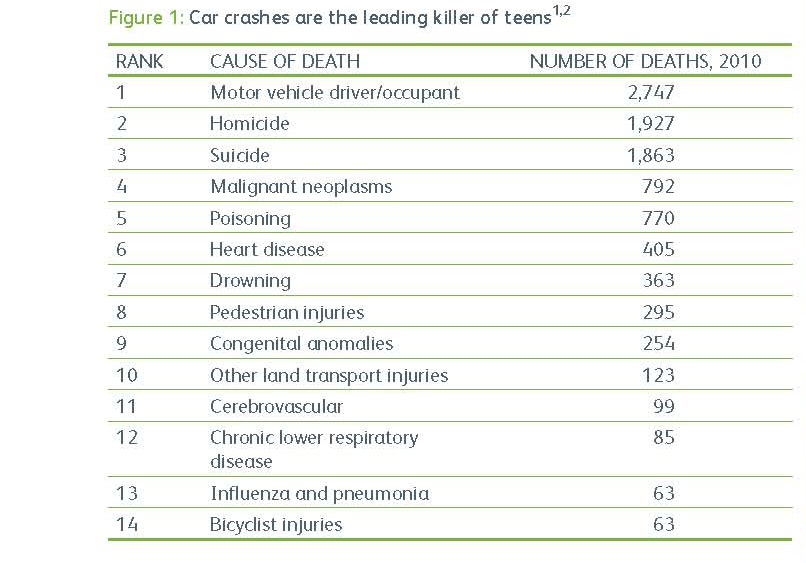
Fortunately, we have seen a steady decline in the number of teens ages 13
to 19 who die each year in motor vehicle crashes—a sign that the efforts
of government, non-profits and industry may be making a difference. Since
reaching a peak of 5,491 deaths in 2002, the number of teens dying in car
crashes has fallen 56 percent to 2,439 in 2012 (Figure 2). *8

Despite the good news, there is still a big challenge facing families—making
sure that their teen isn’t one of the 2,439 who don’t see their next birthday.
One of the most important steps that anyone riding in a car can take to stay
safe is to always use a seat belt, for every ride. And with seat belts available
in every car, there’s no reason not to use them. However, crash data shows
that teens are often not using seat belts at the time of their crash.
In 2012, 1,357 teen drivers, 1,065 passengers, and 17 unknown occupants
died in fatal crashes. Of those, 46.8 percent of drivers and 54.2 percent of
passengers weren’t buckled up at the time of the crash.4 In nonfatal crashes,
we see a similar pattern but with much smaller percentages: in 2012, 5.6
percent of the 132,842 teen drivers injured in crashes weren’t using seat
belts, compared to 11.2 percent of the 111,377 teen passengers (Figure
3). *5
We hypothesize that the difference between fatal and nonfatal crashes
might be a result of seat belts protecting teens who were nonfatally injured
in crashes from being fatally injured. Additionally, the proportion of fatalities
that weren’t using seat belts at the time of the crash has changed very little
over the last decade (Figure 4). *4
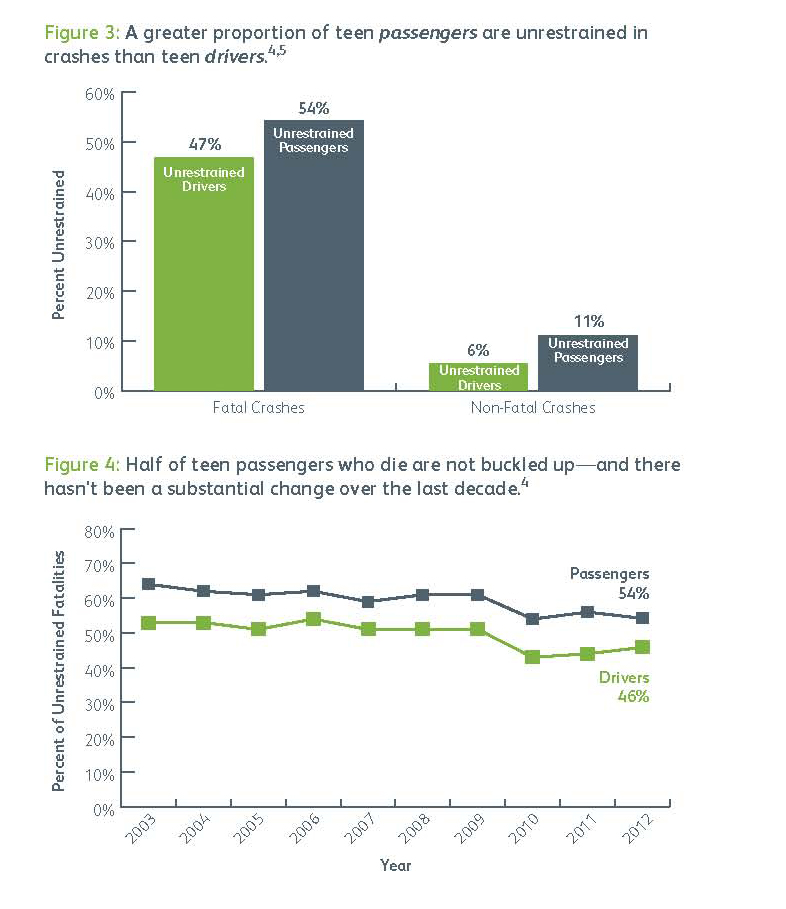
Given that half of the teens who die in car crashes weren’t using their seat
belt at the time of the crash, we wanted to explore why teens don’t always
buckle up and why they thought other teens might not wear seat belts. We
also wanted to know if teens felt safe riding as passengers with a teen driver,
the types of risky situations they’ve been in—such as riding with a teen driver
who was texting—and what they did about it.
Riding in Cars with Teens
To explore the behaviors and thoughts of teens when they ride with a teen
driver, we surveyed 1,051 teens between the ages of 13 and 19. We asked
about how often they ride with a teen driver, whether they use a seat belt,
and their perceptions about other teens’ seat belt use.
We found that beginning at age 15, teens ride more regularly with teen
drivers. Ten percent of 13-year-olds say they ride every day or a few times
a week with a teen driver, compared to 23 percent of 16-year-olds (Figure
5). Along with more frequent exposure to risky situations, however, comes
greater risk: three times as many 16-year-old passengers die in car crashes,
compared to 13-year-olds.3 Previous research has found that, compared
to teen drivers who aren’t transporting any teen passengers, having one
passenger in the car who is under 21 years old increases the risk of a crash by
44 percent; two passengers doubles the risk; and three or more passengers
increases the risk four-fold, when no adult passengers are present. *9
Another study found that in 42 percent of fatal crashes involving a 16 or 17-year-old
driver, all of the passengers in the car were between the ages of 13 and 19. *10
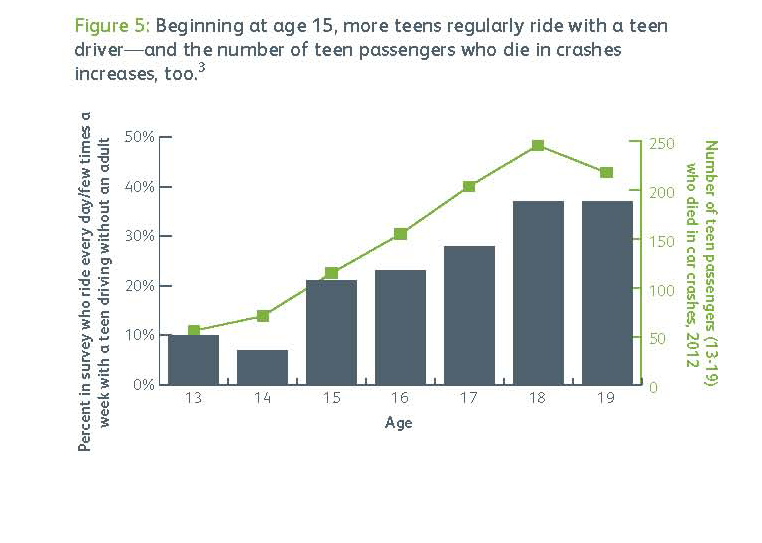
Seat Belts
We found that one in four teens say they don’t use a seat belt every single
time they ride with a teen driver without an adult (Figure 6). Yet wearing a
seat belt is one of the easiest and most effective ways to stay safe as a driver
or passenger. In addition to being available in all cars, when used, seat belts
reduce the risk of death for front seat passengers by 45 percent. *12
In our survey, we found that there are some important differences between
teens who use a seat belt every time they ride with a teen driver, and those
who don’t (Figure 7). For example, we found in the survey that teens who
don’t use a seat belt every time are more likely to have parents who don’t
always use seat belts. And the top reason teens gave for why they didn’t use
a seat belt every time when riding with a teen driver was that they forgot
or it wasn’t a habit (34 percent) (Figure 8). They also said they wouldn’t use
a seat belt if they weren’t traveling far (16 percent), if the seat belts were
uncomfortable (11 percent), or if they were in a hurry (5 percent). This data,
on top of the fact that many of these teens admitted their parents don’t
use a seat belt every time, suggests that buckling up is a practice that starts
young—when children are riding in car seats and watching their parents
behavior over many years.
When teenagers were asked whether other teens always used their seat
belts, their perspectives changed. Although 77 percent of teens say they use
a seat belt every single time they ride with a teen driver, only 16 percent
think other teens use a seat belt every time when riding with a teen driver.
Eight out of ten teens think other teens are less likely to buckle up when not
driving far, and half said that not having enough seat belts in the car for all
the passengers was a reason (Figure 9). Thirty-three percent said that going
to a party was a reason why teens might not wear seat belts; girls were more
likely (36 percent) than boys (29 percent) to use this reasoning. Using a seat
belt isn’t important just for the passenger’s safety; a study found that having
a passenger who wasn’t using a seat belt sitting behind a restrained driver
increased the risk of death to the driver by 137 percent, compared to having
a passenger who was using a seat belt behind them. *13
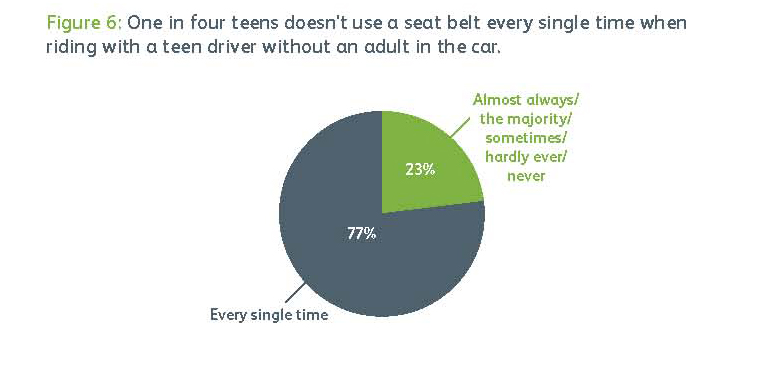
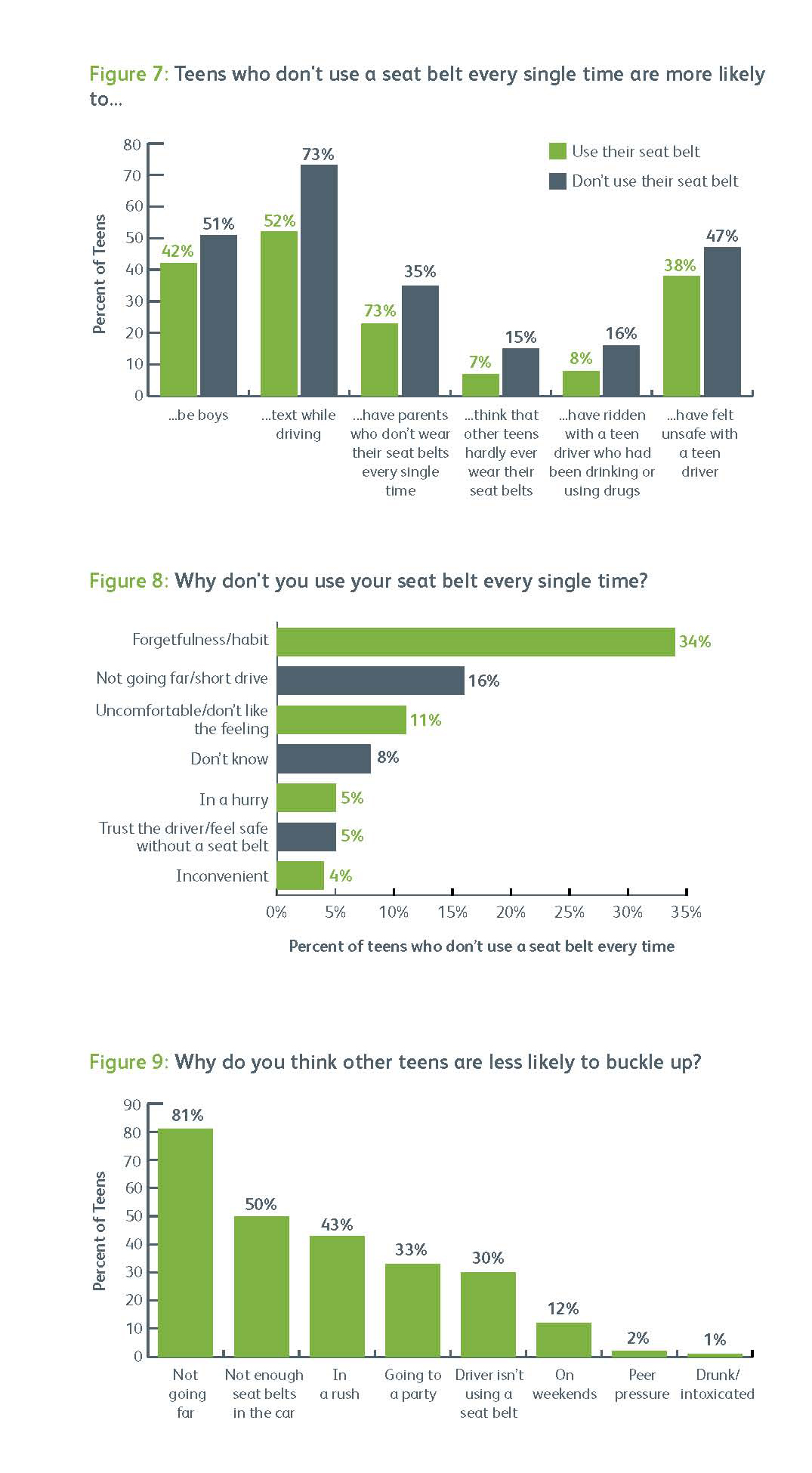
Teen Passengers Are Concerned about Their Safety
Forty-nine percent of teens say there has been a time when they felt unsafe
riding with a teen driver without an adult in the car, and 31 percent have felt
unsafe with a parent driving (Figure 10). The fact that such a large proportion
of teens have felt unsafe as a passenger is alarming. Given that so many
teens were concerned about their safety, we wanted to understand what
types of situations teens were confronted with as passengers.

Four out of 10 teens report riding as a passenger with a teen driver who was
talking on a phone (Figure 11). While we are aware of the risk that behaviors
like speeding and drunk driving pose, dialing a phone can be a danger, too:
one study found that the odds of a crash or near-crash in newly-licensed teen
drivers was more than 8 times greater when dialing a cell phone. *14 In our
survey, we found that forty-two percent of teens say they have ridden with a
teen driver who was speeding or driving recklessly, and 39 percent have been
in the car with a teen driver who was texting. We heard from teens that 95
percent think other teens have ridden with drivers who were texting, showing
just how widespread this issue is.
Given that parents are role models for their children, we asked teens what
they’ve seen their parents do when riding with them. Almost six in 10 have
ridden with a parent who was talking on the phone, 28 percent have been
with a parent who was texting, and 17 percent say they have been in an
crash that was another driver’s fault.
Speaking up to an unsafe teen driver is a challenge for many in the survey;
40 percent of teens say they ask the driver to stop what they’re doing, but
another 39 percent say they do nothing (Figure 12). However, given that so
many teens are reporting their parents’ unsafe driving behaviors, it’s worth
asking: is it more difficult to ask a teen to stop texting while they’re driving,
or to ask a parent to stop being unsafe?
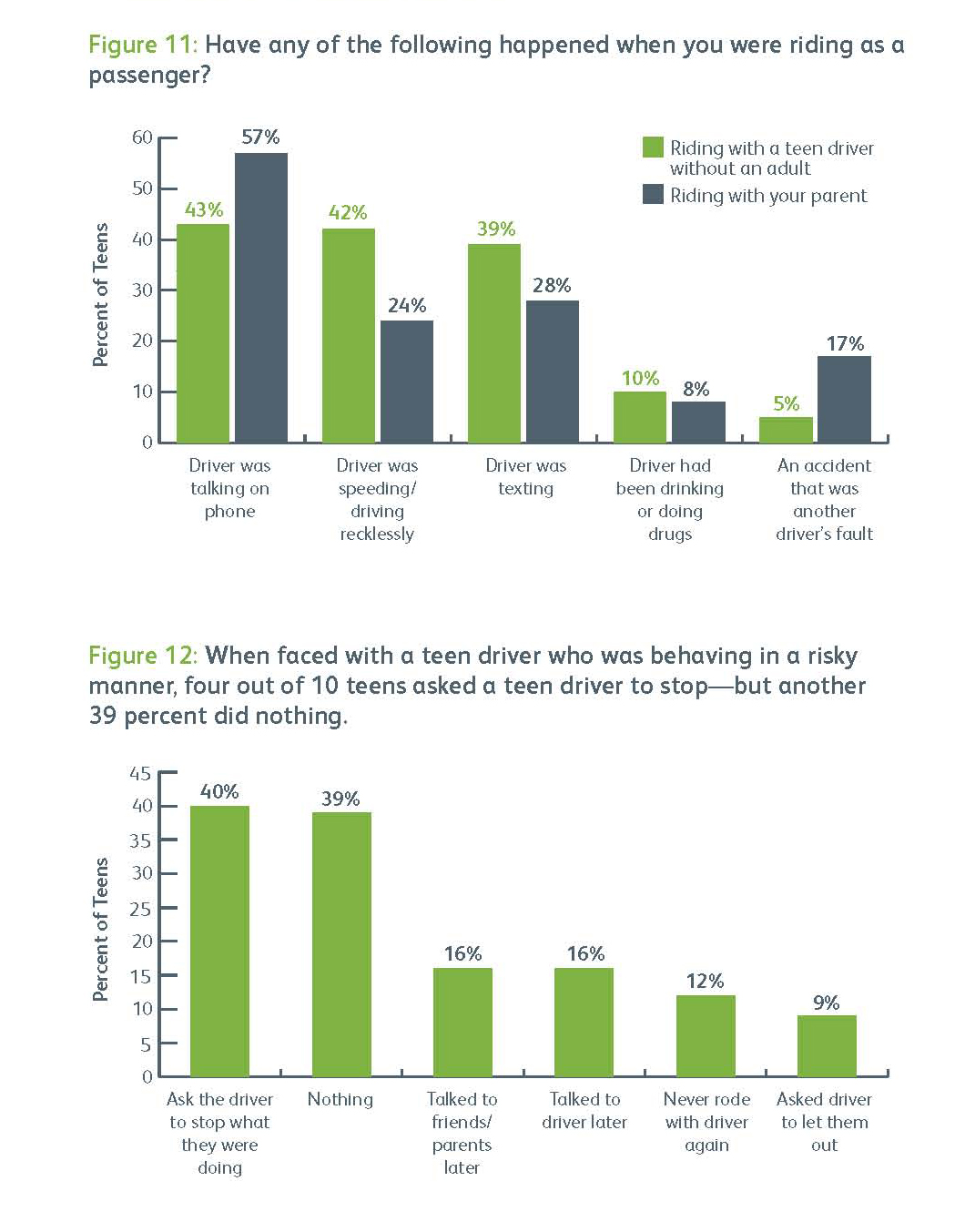
How Public Policy Can Save Teen Lives
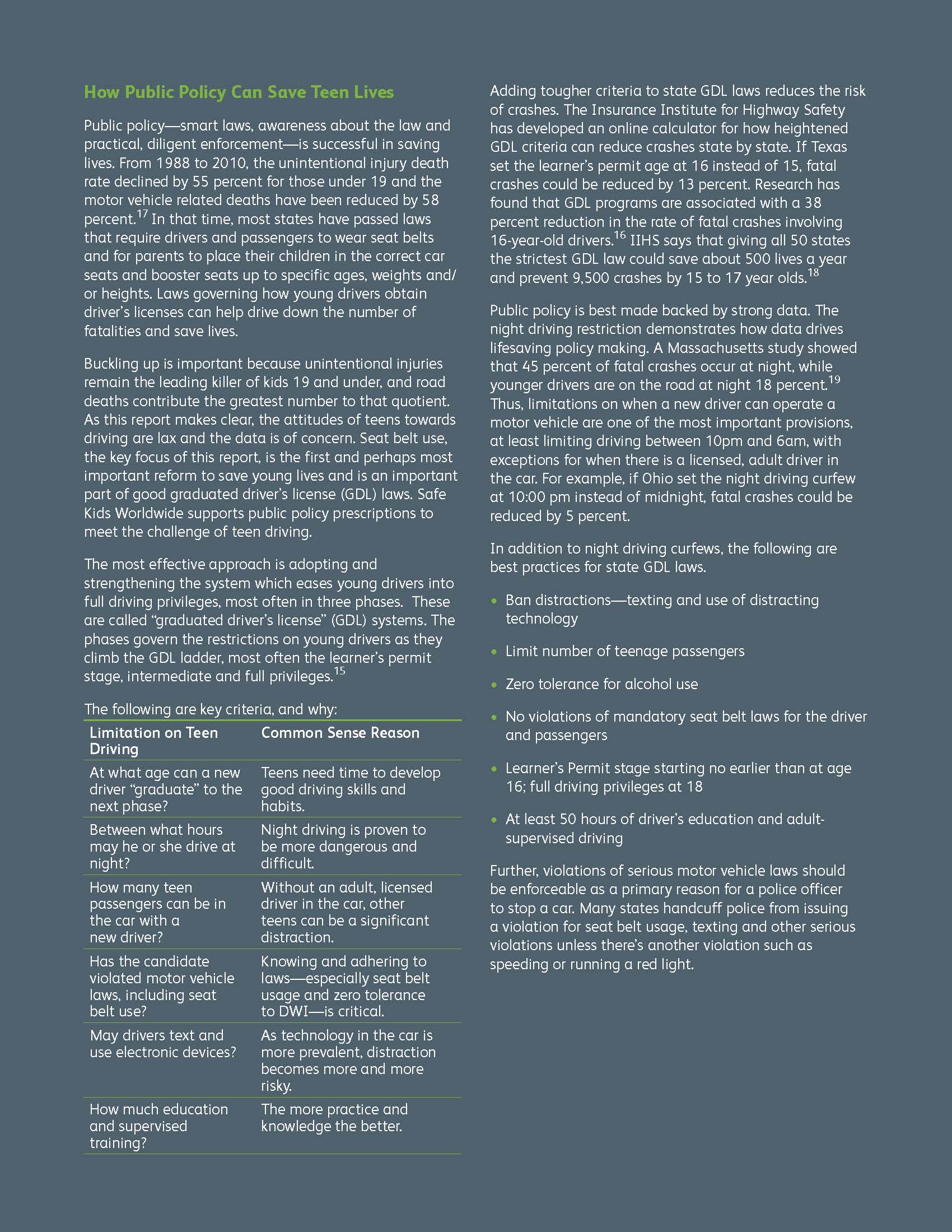
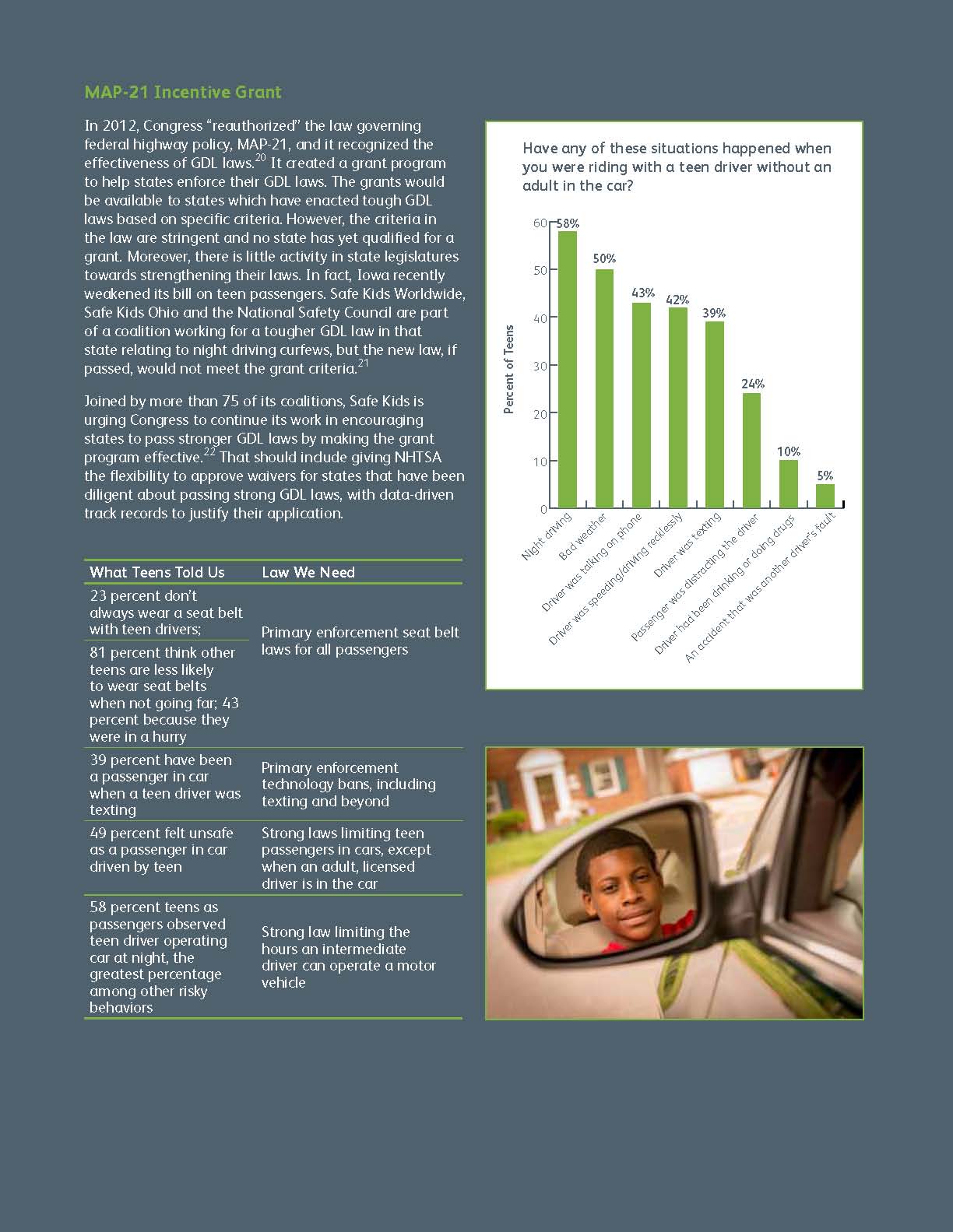
Strategies for Families
As a parent, it can feel impossible to know what teens are up to when riding
with a teen driver. However, we learned that teens are faced with tough
decisions and challenging situations as both passengers and drivers. Here are
strategies for families to spark discussion and to make life-saving behavior
changes.
Make using a seat belt for every ride a habit, starting when kids
are young.
Teens whose parents don’t use seat belts for every ride are less likely to
buckle up themselves. And the top reason that teens gave for not buckling
up was that they forgot or it wasn’t a habit. Using a seat belt for every ride is
one of the easiest ways to stay safe in a car; they’re available in all cars, and
wearing a seat belt lowers the risk of death for a front seat passenger by 45
percent. *12 Make sure that buckling up the whole family is a habit that begins
at a young age.
Be a safety role model by observing speed limits, putting phones away
while driving, and following the rules of the road.
Teens are aware when their parents aren’t following the rules—28 percent
say they’ve seen their parent texting while driving, the same behavior that
every teen driver is told can lead to crashes. Even worse, these habits can lead
to teens feeling unsafe when their parents are driving, such as the 31 percent
of teens in our survey who reported not feeling safe when a parent was
driving. Consider that you’re a safety role model for your child or teenager—
be an example for your kids, starting from when they are watching you from
their car seats in the back seat.
Talk to teens and kids about ways to speak up if a driver of any age
isn’t driving safely.
It’s never easy to be the one speaking out about unsafe behavior. But with 39
percent of teens doing nothing when confronted with an unsafe teen driver,
it’s important to give teens the confidence they need to speak up in these
situations. Try giving them examples of situations in which they’re riding with
a driver who isn’t safe—such as texting or speeding—and ask them what
they would do. Then, tell them what some safe options would be, such as
asking the driver to slow down or ask to be dropped off at a shopping center
and call a parent to be picked up.
By engaging with these strategies, we hope that parents and teens can stay
safe while riding in cars as both passengers and drivers.
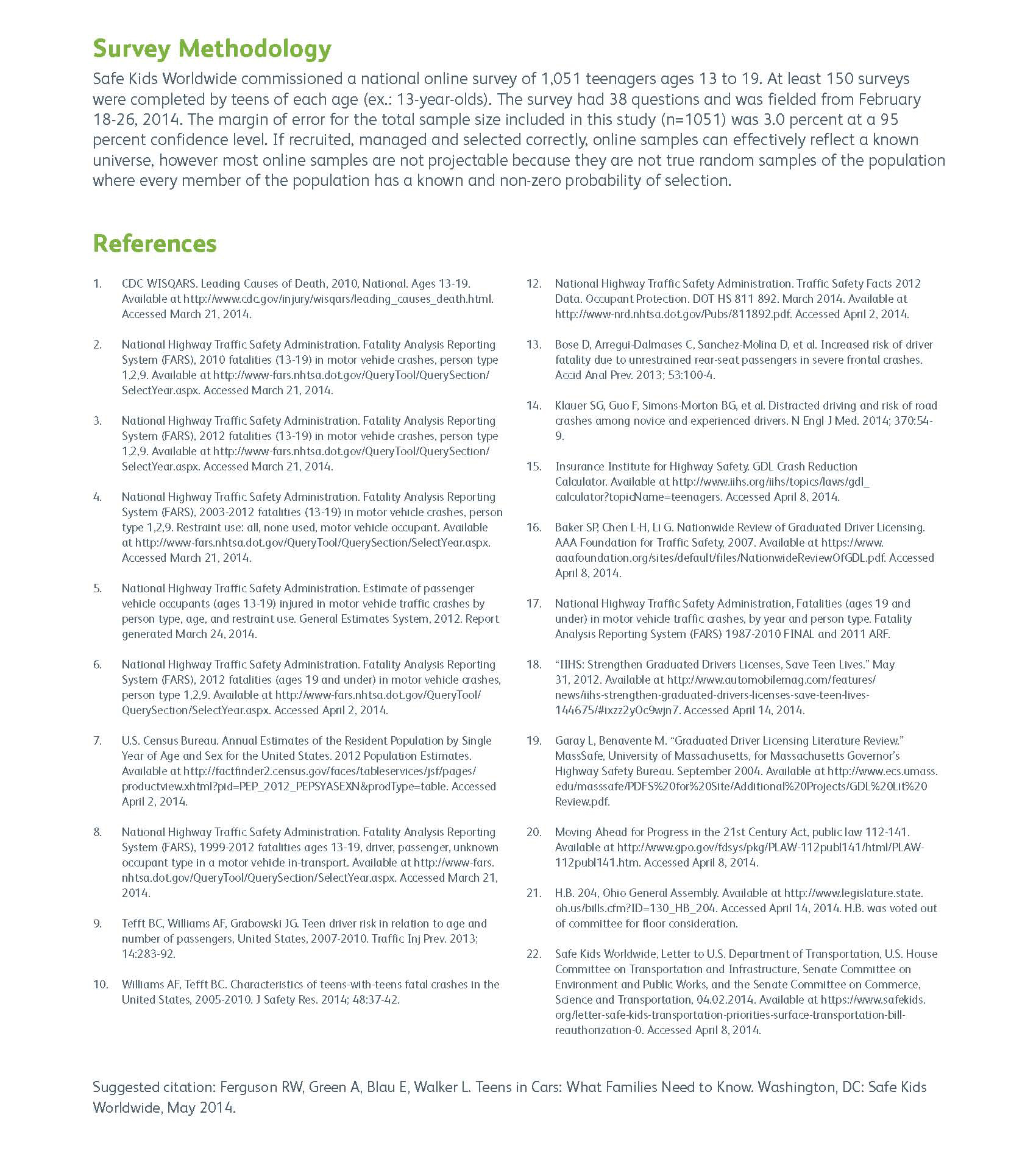
About Safe Kids
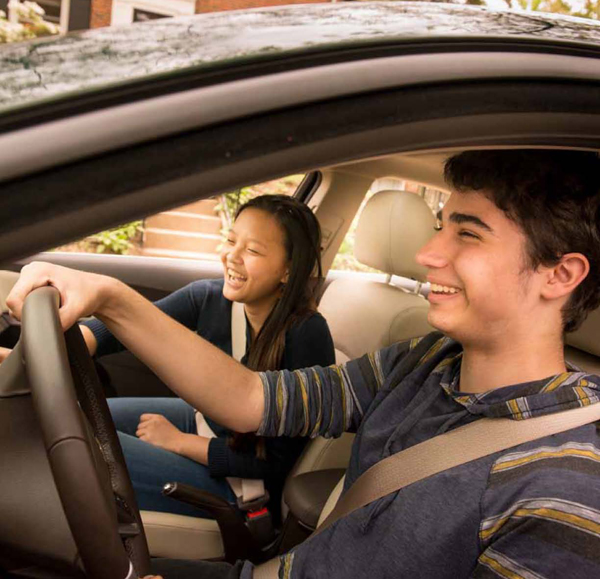 Safe Kids Worldwide is a global organization dedicated to preventing injuries in children, the number one killer of kids in the United States. Around the world, a child dies from an unintentional injury every 30 seconds. And millions of children are injured in ways that can affect them for a lifetime.
Safe Kids Worldwide is a global organization dedicated to preventing injuries in children, the number one killer of kids in the United States. Around the world, a child dies from an unintentional injury every 30 seconds. And millions of children are injured in ways that can affect them for a lifetime.
When a child dies or is seriously injured, the lives of families and entire communities are changed forever. But these tragedies don’t have to happen. The important thing to remember about preventable injuries is that they are preventable. They often occur in predictable ways and can be completely avoided with the right education, awareness and planning.
Safe Kids works with an extensive network of more than 600 coalitions in the United States and partners with organizations in 23 countries around the world to reduce injuries from motor vehicles, sports, drownings, falls, burns, poisonings and more.
Since 1988, when Safe Kids was founded by Dr. Marty Eichelberger of the Children’s National Medical Center with support from founding sponsor, Johnson & Johnson, there has been a 55 percent decrease in the unintentional injury rate among children 19 years and younger.
But losing one child is one too many, and we don’t want any parent to have to endure the loss of a child. That’s why we’re calling on everyone to come together, to raise awareness and to get involved so we can ensure that all children around the world have the chance to grow up healthy and safe, and do all the great things kids were meant to do.
Safe Kids Worldwide
1301 Pennsylvania Avenue N.W.
Suite 1000
Washington, DC 20004
Phone: 202.662.0600
www.safekids.org
